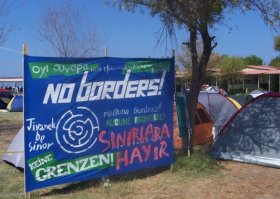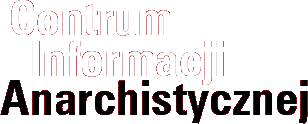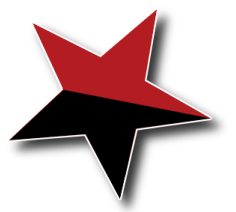No Border Camp in Turkey
 The Aegean Coast of Turkey is very close to Greece and many Greek Islands; it is one of the external borders of the European Union. Groups of refugees, seeking a close and relatively easy route, try to cross the sea, especially at night. Turkey has long land borders with countries like Syria, Iran and Iraq and refugees, especially from these last two countries, are among those trying to get across the sea. There is also a large number of refugees from Somalia, Mauritania, Eritrea, Pakistan and Palestine who made their way to Turkey. Recently even refugees from as far away as Burma have been caught trying to leave Turkey for the EU.Turkey, who is still talking with the EU about possible accession or at least having permanent "special relations", is coming under increasing pressure and is receiving more and more money to police the borders and to stop the refugees before they can even make their way to the sea.
The Aegean Coast of Turkey is very close to Greece and many Greek Islands; it is one of the external borders of the European Union. Groups of refugees, seeking a close and relatively easy route, try to cross the sea, especially at night. Turkey has long land borders with countries like Syria, Iran and Iraq and refugees, especially from these last two countries, are among those trying to get across the sea. There is also a large number of refugees from Somalia, Mauritania, Eritrea, Pakistan and Palestine who made their way to Turkey. Recently even refugees from as far away as Burma have been caught trying to leave Turkey for the EU.Turkey, who is still talking with the EU about possible accession or at least having permanent "special relations", is coming under increasing pressure and is receiving more and more money to police the borders and to stop the refugees before they can even make their way to the sea.
In the beginning of Sept., the first NoBorder Camp was held in Turkey and brought toegther people who oppose the border regime and who would like to take some action.
In the month prior to the camp, a few round-ups of refugees took place in Turkey, At the beginning of June, the polce and coastguards conducted an operation over 10 days around Didim. They arrested a total of 250 people without documents coming from Palestine, Iraq, Mauritania and Somalia. On the grounds that it is too hot and that the streets are blocked, these people, including 4 women and two children, were detained in the stadium in Didim. On June 14, people tried, unsuccessfully, to escape. Within days of this, they also stopped 16 people in a boat going to Samos, 15 people in a truck near Didim and 20 in a border town near Greece. These are just some of the examples of the round-ups being made these days in Turkey.
In order to fulfill a "harmonization strategy" on the protection of the external borders as a part of the efforts of alignment with the EU legislation and practice, Turkey set up a Task Force for Asylum, Migration and Protection of
External Borders in 2002. It is coordinated by the Ministry of Interior. It cooperates with the Aliens, Borders, Asylum Department of the General Directorate of Security, General Staff, Ministry of Foreign Affairs, Undersecretariat of
Customs, General Command of Gendarmerie and the Coast Guard Command. Three separate working groups connected to this task force were established in the fields of “asylum”, “migration” and “external borders.”
In January 2006 a new Accession Partnership (AP) document was adopted by the EU laying out the tasks that Turkey had to complete for convergence to occur between Turkish legislation and the EU acquis. However some politicians have become reluctant to adopt and implement the acquis since they do not believe that Turkey will really join the EU. In this respect, while increasing border management on the whole, there is some reluctance to implement all of the EU's requests. For example, Turkey does not want to sign a Dublin II type agreement which would require them to take refugees back to Turkey. This, however, probably has more to do with the attitudes towards migrants and immigrants than anything else. Despite not signing this, there have been reports of Iraqis being sent back to Turkey on more than one occasion, from Italy and from Greece. UNHCR reports that 135 Iraqis who were sent to Turkey from Greece last year were then deported to Iraq.
People from Amnesty International told the participants of the camp more about the conditions that asylum seekers were facing. They explained that, in order to avoid having scrutiny of their detention centers, Turkey officially calls detention centers "guesthouses" and claims they have no detention centers. These detention prisons, falsely labeled "guesthouses" are located in Van, Hatay, Ankara, Izmir, Edirne, Kirklareli and Istanbul. Turkey, which does not want to give asylum, requires refugees seeking asylum to file applications with UNHCR and try to get accepted to another country like the US or Finland. Few of the people detained know how to do this and the officials do not want to let people in to help them. The refugee coordinator of AI explained that she herself was never allowed inside a detention center. Still, another AI coworker has been, and it is possible to speak to people who have been inside and find out about conditions. Usually, they are appalling, with insufficient food, water and other resources. Centers for 300 people have been known to have over a thousand at any time. There have been mass hunger strikes and other forms of protest at the centers.
(More information about the detainees can be found on the internet in the 2008 RASP Report on Refugee Detention in Turkey. See the next post on the English section of this site.)
Besides the interesting and horrible information given by local activists, people from Lesbos also told about their observations of Frontex operations in the Aegean. These take place in the framework of "Operation Poseidon". There is an Italian ship there, a helicopter, and Maltese troops, among other things. The Frontex people claim to be "saving" people, but there is no sign of people they "save'. (On the other hand, the detention and even abuse of migrants on Lesbos, as well as Samos and Chios was documented in the fall of 2007. The Pro-Asyl group published a report after interviewing migrants from 12th July and the 14th August 2007 on Lesbos, Samos and Chios. The conditions were unacceptable and some people were beaten and even tortured in detention.) There was discussion about the need to better document Frontex's work and also to speed up international actions against this agency.
The camp saw a number of such interesting workshops. Despite the annoying problems that the local people had with the authorities that created some logistic problems, the camp went quite smoothly with a lot of collective spirit and teamwork. About 150 people participated in the camp from a dozen or more places such as Turkey, Greece, Austria, Russia, Poland, Germany, Belarus, Israel, Canada, Belgium, Sweden and probably a few other places I forgot to mention. The camp was located at the seaside, with a view on the island of Lesbos in the seaside town of Dikili. During the camp, besides the workshops, there were films, music, poetry and exhibitions. There was also an exhibition in the center of the town and a film night for the locals, who were also invited to participate in the events at the camp.
At the end of the camp, a number of symbolic actions took place, like erecting a fake border and making a monument to the refugees who died at sea with red stones on the beach. Pictures of the actions can be found here:
http://de.indymedia.org/2008/09/226399.shtml
http://de.indymedia.org/2008/09/226556.shtml
A few other photos are here:
https://cia.media.pl/turcja_drugi_dzien_obozu_antygranicznego_w_dikili
The activists decided to hold another camp next year in Diyabakir. There will be some large international leftist events there next summer and probably the camp will happen around the same time.






